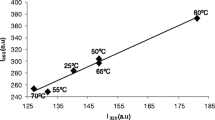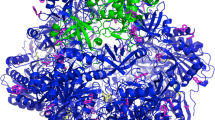Abstract
Tissue transglutaminase undergoes thermal inactivation with first-order kinetics at moderate temperatures, in a process which is affected in opposite way by the regulatory ligands calcium and GTP, which stabilize different conformations. We have explored the processes of inactivation and of unfolding of transglutaminase and the effects of ligands thereon, combining approaches of differential scanning calorimetry (DSC) and of thermal analysis coupled to fluorescence spectroscopy and small angle scattering. At low temperature (38–45°C), calcium promotes and GTP protects from inactivation, which occurs without detectable disruption of the protein structure but only local perturbations at the active site. Only at higher temperatures (52–56°C), the protein structure undergoes major rearrangements with alterations in the interactions between the N- and C-terminal domain pairs. Experiments by DSC and fluorescence spectroscopy clearly indicate reinforced and weakened interactions of the domains in the presence of GTP and of calcium, and different patterns of unfolding. Small angle scattering experiments confirm different pathways of unfolding, with attainment of limiting values of gyration radius of 52, 60 and 90 Å in the absence of ligands and in the presence of GTP and calcium. Data by X-rays scattering indicate that ligands influence retention of a relatively compact structure in the protein even after denaturation at 70°C. These results suggest that the complex regulation of the enzyme by ligands involves both short- and long-range effects which might be relevant for understanding the turnover of the protein in vivo.






Similar content being viewed by others
References
Bergamini CM, Dean M, Matteucci G, Hanau S, Tanfani F, Ferrari C, Boggian M, Scatturin A (1999) Conformational stability of human erythrocyte transglutaminase. Patterns of thermal unfolding at acid and alkaline pH. Eur J Biochem 266:575–582
Bergamini CM (2007) Effects of ligands on the stability of tissue transglutaminase: studies in vitro suggest possible modulation by ligands of protein turn-over in vivo. Amino Acids 33:415–421
Bergamini CM, Dondi A, Lanzara V, Squerzanti M, Cervellati C, Montin K, Mischiati C, Tasco G, Collighan R, Griffin M, Casadio R (2010) Thermodynamics of binding of regulatory ligands to tissue transglutaminase. Amino Acids 39:297–304
Bergamini CM, Collighan RJ, Wang Z, Griffin M (2011) Structure and regulation of type 2 transglutaminase in relation to its physiological functions and pathological roles. Adv Enzymol 78:1–46
Boatright KM, Salvesen GS (2003) Mechanisms of caspase activation. Curr Opin Cell Biol 15:725–731
Casadio R, Polverini E, Mariani P, Spinozzi F, Carsughi F, Fontana A, Polverino de Laureto P, Matteucci G, Bergamini CM (1999) The structural basis for the regulation of tissue transglutaminase by calcium ions. Eur J Biochem 262:672–679
Cervellati C, Franzoni L, Squerzanti M, Bergamini CM, Spinozzi F, Mariani P, Lanzara V, Spisni A (2009) Unfolding studies of tissue transglutaminase. Amino Acids 36:633–641
Cinelli S, Spinozzi F, Itri R, Finet S, Carsughi F, Onori G, Mariani P (2001) Structural characterization of the pH-denatured states of ferricytochrome-c by synchrotron small angle X ray scattering. Biophys J 81:3522–3533
Cioni P, Strambini GB (2002) Effect of heavy water on protein flexibility. Biophys J 82:3246–3253
Di Venere A, Rossi A, De Matteis F, Rosato N, Finazzi-Agrò A, Mei G (2000) Opposite effects of Ca2+ and GTP binding on tissue transglutaminase tertiary structure. J Biol Chem 275:3915–3921
Fabbi M, Marinpietri D, Martini S, Brancolini C, Amoresano A, Scaloni A, Bargellesi A, Cosulich E (1999) Tissue transglutaminase is a caspase substrate during apoptosis. Cleavage causes loss of transamidating function and is a biochemical marker of caspase 3 activation. Cell Death Differ 6:992–1001
Feng JF, Gray CD, Im MJ (1999) Alpha 1B-adrenoceptor interacts with multiple sites of transglutaminase II: characteristics of the interaction in binding and activation. Biochemistry 38:2224–2232
Fesüs L, Szondy Z (2005) Transglutaminase 2 in the balance of cell death and survival. FEBS Lett 579:3297–3302
Folk JE, Cole PW (1966) Transglutaminase: mechanistic features of the active site as determined by kinetic and inhibitor studies. Biochim Biophys Acta 122:244–264
Griffin M, Casadio R, Bergamini CM (2002) Transglutaminases: nature’s biological glues. Biochem J 368:377–396
Guinier A, Fournet G (1955) Small angle scattering of X-rays. Wiley, New York
Gundemir S, Johnson GV (2009) Intracellular localization and conformational state of transglutaminase 2: implications for cell death. PLoS One 4:e6123
Iismaa SE, Holman S, Wouters MA, Lorand L, Graham RM, Husain A (2003) Evolutionary specialization of a tryptophan indole group for transition-state stabilization by eukaryotic transglutaminases. Proc Natl Acad Sci USA 100:12636–12641
Iismaa SE, Mearns BM, Lorand L, Graham RM (2009) Transglutaminases and disease: lessons from genetically engineered mouse models and inherited disorders. Physiol Rev 89:991–1023
Jaenicke R (2000) Stability and stabilization of globular proteins in solution. J Biotechnol 79:193–203
Kurochkin IV, Procyk R, Bishop PD, Yee VC, Teller DC, Ingham KC, Medved LV (1995) Domain structure, stability and domain-domain interactions in recombinant factor XIII. J Mol Biol 248:414–430
Lai TS, Slaughter TF, Koropchak CM, Haroon ZA, Greenberg CS (1996) C-terminal deletion of human tissue transglutaminase enhances magnesium-dependent GTP/ATPase activity. J Biol Chem 271:31191–31195
Lentini A, Abbruzzese A, Caraglia M, Marra M, Beninati S (2004) Protein-polyamine conjugation by transglutaminase in cancer cell differentiation: review article. Amino Acids 26:331–337
Lichti U, Ben T, Yuspa SH (1985) Retinoic acid-induced transglutaminase in mouse epidermal cells is distinct from epidermal transglutaminase. J Biol Chem 260:1422–1426
Mariani P, Carsughi F, Spinozzi F, Romanzetti S, Meier G, Casadio R, Bergamini CM (2000) Ligand-induced conformational changes in tissue transglutaminase: Monte Carlo analysis of small-angle scattering data. Biophys J 78:3240–3251
Millett IS, Doniach S, Plaxco KW (2002) Towards a taxonomy of the denatured state: small angle scattering studies of unfolded proteins. In: Rose GD (ed) Advances in protein chemistry, vol. 62. Academic Press, San Diego, pp 241–262
Monsonego A, Friedmann I, Shani Y, Eisenstein M, Schwartz M (1998) GTP-dependent conformational changes associated with the functional switch between Galpha and cross-linking activities in brain-derived tissue transglutaminase. J Mol Biol 282:713–720
Nury S, Meunier JC, Mouranche A (1989) The kinetics of the thermal deactivation of transglutaminase from guinea-pig liver. Eur J Biochem 180:161–166
Nury S, Meunier JC (1990) Molecular mechanisms of the irreversible thermal denaturation of guinea-pig liver transglutaminase. Biochem J 266:487–490
Pinkas DM, Strop P, Brunger AT, Khosla C (2007) Transglutaminase 2 undergoes a large conformational change upon activation. PLoS Biol 5:e327
Privalov G, Kavina V, Freire E, Privalov PL (1995) Precise scanning calorimeter for studying thermal properties of biological macromolecules in dilute solution. Anal Biochem 232:79–85
Segel DJ, Fink AL, Hodgson KO, Doniach S (1998) Protein denaturation: a small-angle X-ray scattering study of the ensemble of unfolded states of cytochrome c. Biochemistry 37:12443–12451
Smethurst PA, Griffin M (1996) Measurement of tissue transglutaminase activity in a permeabilized cell system: its regulation by Ca2+ and nucleotides. Biochem J 313:803–818
Sohn J, Kim TI, Yoon YH, Kim JY, Kim SY (2003) Novel transglutaminase inhibitors reverse the inflammation of allergic conjunctivitis. J Clin Invest 111:121–128
Svergun DI, Petoukhov MV, Koch MH (2001) Determination of domain structure of proteins from X-ray solution scattering. Biophys J 80:2946–2953
Tsou CL (1995) Inactivation precedes overall molecular conformation changes during enzyme denaturation. Biochim Biophys Acta 1253:151–162
Uversky VN, Dunker AK (2010) Understanding protein non-folding. Biochim Biophys Acta 1804:1231–1264
Verderio E, Nicholas B, Gross S, Griffin M (1998) Regulated expression of tissue transglutaminase in Swiss 3T3 fibroblasts: effects on the processing of fibronectin, cell attachement and cell death. Exp Cell Res 239:119–138
Volkman BF, Lipson D, Wemmer DE, Kem D (2001) Two-state allosteric behavior in a single-domain signaling protein. Science 291:2429–2433
Zhang J, Lesort M, Guttmann RP, Johnson GV (1998) Modulation of the in situ activity of tissue transglutaminase by calcium and GTP. J Biol Chem 273:2288–2295
Acknowledgments
Authors express their gratitude to Prof. Franco Dallocchio for help in the thermodynamic analysis of the calorimetric data. These experiments were supported by research grants from the University of Ferrara and from the Fondazione della Cassa di Risparmio di Ferrara.
Author information
Authors and Affiliations
Corresponding author
Rights and permissions
About this article
Cite this article
Cervellati, C., Montin, K., Squerzanti, M. et al. Effects of the regulatory ligands calcium and GTP on the thermal stability of tissue transglutaminase. Amino Acids 42, 2233–2242 (2012). https://doi.org/10.1007/s00726-011-0963-6
Received:
Accepted:
Published:
Issue Date:
DOI: https://doi.org/10.1007/s00726-011-0963-6




